

21. Synthesis and transformation of radialenes |
947 |
in dimethylacetamide under an argon atmosphere gave a red solution, which had a similar absorption spectrum as radialene 74a and turned blue on admission of air with formation of dication 75b.
The thermally or photochemically induced (2 C 2) cyclodimerization of butatrienes across the central CDC double bond, or of higher cumulenes at an inner double
bond, appears as |
a reasonable route to [4]radialenes. However, success and failure |
of this approach |
have been reported about equally often. Butatriene itself yields |
1,5-cyclooctadiyne and other products, but no [4]radialene, on heating45. Silyl-, stannyland germyl-substituted butatrienes seem to undergo no thermal dimerization at all46. In contrast to earlier assumptions, the photochemical dimerization of tetraphenyland tetrakis(4-methoxyphenyl)butatriene as well as the thermal dimerization of 7-(propadienylidene)tricyclo[4.1.0]heptane do not provide the respective [4]radialenes, but occur at one of the terminal CDC bonds to give a head-to-tail dimer in the former case47 and a head-to-head dimer in the latter48. Some [4]radialenes which have been obtained by thermal (100 200 °C) cyclodimerization of [n]cumulenes are given below. It appears that only butatrienes bearing electron-withdrawing substituents are able to form [4]radialenes (e.g. 7649, 7750, 7851). On heating, radialene 79 was obtained from a pentatetraene52, and 80 from a hexapentaene53,54, but it must be mentioned that different cyclodimers are formed when these cumulene systems bear other alkyl substituents48,55,56.
|
|
t-Bu |
t-Bu |
O |
|
|
|
|
|
O |
|
|
|
|
|
Cl |
Cl |
|
|
|
|
MeOOC |
COOMe |
Cl |
|
t-Bu |
|
|
Bu-t |
Ph |
Ph |
|
Cl |
|
|
|
|||
Cl |
|
Cl |
|
|
Bu-t |
Ph |
Ph |
|
|
t-Bu |
|
|
|
|
|
Cl |
Cl |
|
|
|
|
COOMe COOMe |
|
|
|
O |
|
|
O |
|
|
|
|
t-Bu |
t-Bu |
|
|
|
|
|
(76) |
|
(77) |
|
|
|
(78) |
|
|
t-Bu |
|
t-Bu |
t-Bu |
|
|
|
|
|
|
|
|
|
|
|
H |
• |
t-Bu |
• |
• |
Bu-t |
|
|
|
|
|
||||
|
H |
• |
|
• |
• |
|
|
|
|
t-Bu |
Bu-t |
|
|||
|
|
t-Bu |
|
|
|
||
|
|
|
|
|
|
|
|
|
|
|
|
t-Bu |
|
Bu-t |
|
|
|
(79) |
|
|
(80) |
|
|
1,2,3-Cyclononatriene, the smallest cyclic [3]cumulene isolated so far, polymerizes when its solutions are concentrated57. On the other hand, several radialenes have been isolated which represent cyclodimers of sevenand eight-membered 1,2,3-trienes (Scheme 9).
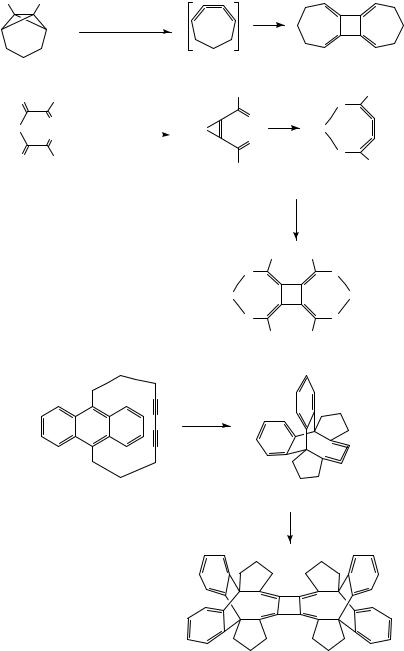
948 |
Gerhard Maas and Henning Hopf |
Br SiMe3
CsF, DMF, 20 ˚C
Ni(PPh3 )4 (10 mol%)
32%
(81) |
|
|
|
|
N2 |
Bu-t |
|
|
|
|
O |
CuO3SCF3 (cat.) |
||
R2 Si |
or Pd (OA c)2 |
(cat.) |
||
O |
||||
|
− 2N2 |
|
||
|
|
|
||
N2 Bu-t
(84)
(82) |
(83) |
|
|
|
t-Bu |
Bu-t |
|
|
|
||
|
|
O |
|
|
|
O |
|
R2 Si |
R2 Si |
||
|
|
O |
|
|
|
O |
|
|
t-Bu |
Bu-t |
|
|
|
(85) |
|
R = Me: 38−40%
R = i-Pr: 5−9%
t-Bu |
t-Bu |
O |
O |
R2 Si |
SiR2 |
O |
O |
t-Bu |
t-Bu |
|
(86) |
hν,
benzene
(87) |
(88) |
dimerization
(89)
SCHEME 9
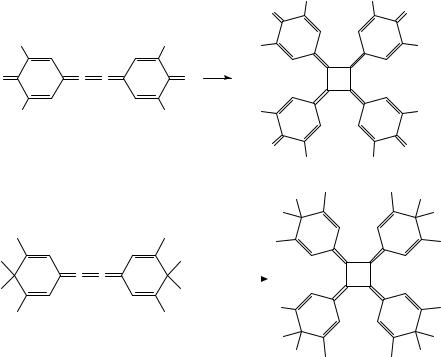
21. Synthesis and transformation of radialenes |
949 |
The parent 1,2,3-cycloheptatriene (82), generated as a reactive intermediate from tricyclus 81, can be trapped with various dienes, but it does not dimerize58. In the presence of Ni(PPh3)4, however, the dimer, i.e. radialene 83 is formed59. Similar to the parent compound (2), it polymerizes on contact with oxygen within a few hours.
Radialenes 86 were obtained when bis(1-diazo-2-oxoalkyl)silanes 84 were decomposed with copper or palladium catalysts60,61. The assumption, that the heterocyclic [3]cumulene 85 is the immediate precursor of 86, is corroborated by its trapping in a Diels-Alder reaction with furan.
Radialene 89, a dimer of 1,2,3-cyclooctatriene derivative 88, was isolated when the [10](9,10)anthracenophane-4,6-diyne 87 was exposed to sunlight62. In this case, the intermediate occurrence of 88 could not only be substantiated by isolation of (4 C 2) cycloadducts in the presence of furan or cyclopentadiene, but also by a UV/Vis spectrum obtained at 77 K in an organic glass.
The cyclodimerization of 82 to 83 is an example of a Ni(0)-mediated synthesis of [4]radialenes from [n]cumulenes. Applications of this method to butatriene derivatives 9050,63, 9164 and 9365,66 are shown in Scheme 10. The usefulness of Ni(0) catalysis for this transformation was first demonstrated by West and coworkers63 and later explored in detail by Iyoda and coworkers42,54,67. In some cases, Ni(0) catalysis improves the efficiency of the process as compared to the purely thermal reaction (e.g. 90 ! 77); in other cases, it is a requirement for a successful [4]radialene synthesis (e.g. 82 ! 83
|
|
|
|
t-Bu |
t-Bu |
|
|
|
|
|
O |
O |
|
t-Bu |
|
|
Bu-t |
t-Bu |
Bu-t |
|
|
|
|
|
|||
O |
• |
• |
|
O |
|
|
t-Bu |
|
|
Bu-t |
t-Bu |
Bu-t |
|
|
|
(90) |
|
|
|
|
150°C: 25% yield |
|
|
O |
O |
||
Ni(PPh3 )2 (CO)2 |
(5 mol-%), C6 H6 |
, 80°C; 95% |
||||
t-Bu |
t-Bu |
|||||
Ni(PPh3 )4 (20 mol-%), C6 H6 , 80°C;50% |
||||||
|
(77) |
|||||
|
|
|
|
|
||
|
|
Ni(PPh3 )2 (CO)2 |
• |
• |
C6 H6 , 80 °C |
|
|
67% |
(91)
(92)
SCHEME 10
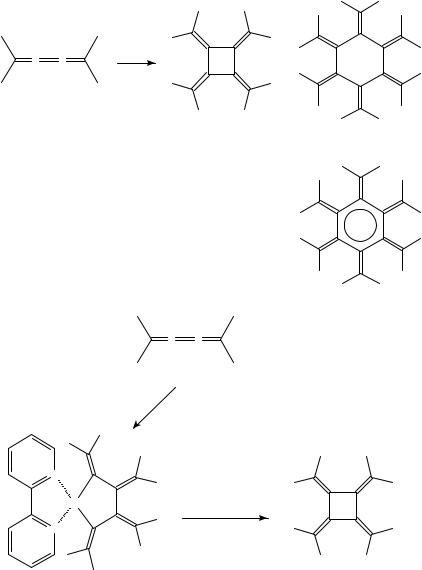
950 |
Gerhard Maas and Henning Hopf |
• |
• |
Ni(0) |
+ |
|
(93) |
|
|
|
(94) |
(95) |
||
|
|
|
|
|
+ |
||
Ni(0) Catalyst |
Solvent |
Temp. |
|
Yield (%) |
|
|
|
|
|
(°C) |
|
|
|
|
|
|
|
94 |
95 |
96 |
|
|
|
|
|
|
|
|
|
|
|
Ni(PPh3 )4 |
C6 H6 |
50 |
7 |
− |
19 |
|
|
Ni(PPh3 )2 (CO)2 |
DMF |
50 |
4 |
24 |
21 |
|
|
C6 H6 |
80 |
11 |
3 |
35 |
|
|
|
|
|
|
|
|
(96) |
||
|
|
• |
• |
|
|
|
|
(93)
80 %
Ni(bpy)(cod),
THF, 5 ˚C
N
Ni
maleic anhydride (2 equiv), THF
N |
79 % |
(94)
(97)
SCHEME 10. (continued)
and 93 ! 94). On the other hand, tetraphenylbutatriene and 2,5-diphenylhexa-2,3,4- triene could not be cyclodimerized with catalytic Ni(PPh3)4 in benzene66. The examples shown in Scheme 10 also illustrate that different Ni(0) catalysts are in use, especially Ni(PPh3)4 [conveniently generated by in situ reduction of NiBr2(PPh3)2, Ni(CO)2(PPh3)2 and Ni(cod)2, cod D 1,5-cyclooctadiene].

21. Synthesis and transformation of radialenes |
951 |
In the case of tetramethylbutatriene, Ni(0) catalyzes not only the cyclodimerization (formation of [4]radialene 94), but also the cyclotrimerization, leading to [6]radialene 95 and its isomer 96 (see also Section II.D). The product pattern depends to some extent on the nature of the catalyst, but the choice of solvent seems to be more crucial65,66. This is illustrated impressively by the Ni(cod)2-catalyzed reaction of 93, which leads exclusively to the [4]radialene in toluene solution, but to the [6]radialene in DMF68. Interestingly, the stoichiometric reaction between 93 and (2,20 -bipyridyl)-(1,5-cyclooctadiene)nickel yields the nickel complex 97, which has been isolated and characterized by X-ray diffraction69. On treatment of 97 with two equivalents of maleic anhydride, reductive elimination of nickel takes place and octamethyl[4]radialene (94) is formed in good yield. This reaction sequence sheds light on the mechanism of the Ni-catalyzed reactions mentioned above; further ideas on the mechanism of the cyclodimerization and cyclotrimerization reactions have been developed by Iyoda and coworkers66.
The Ni(0)-mediated synthesis of [4]radialenes from hexapentaenes has also been investigated42,54,67. The regioselectivity of the cyclodimerization and the question of
|
|
|
|
|
|
|
|
R |
|
|
|
|
|
|
|
|
|
R |
|
• |
R |
|
|
|
|
|
|
|
|
• |
|
|
|
||
R |
|
R |
Ni (PPh3 )4 or |
|
|
R |
|
|
|
|
|
|
|
|
|
|
|
|
|
||||
|
|
|
|
|
|
|
|
|
|||
• |
• • • |
|
Ni (PPh3 )2 (CO)2 |
|
|
|
|
|
|
|
|
|
(0.25 − 1.0 equiv.) |
|
|
|
|
|
|
|
|||
|
|
|
|
|
|
|
|
|
|
||
R |
|
R |
|
|
|
R |
• |
|
|
|
|
|
|
|
|
|
|
• |
|
|
|
||
|
|
|
|
|
|
R |
|
R |
|
|
|
|
|
|
|
|
|
|
|
|
|
||
|
|
|
|
|
|
|
|
|
|
|
|
|
(98) |
|
|
|
|
|
(99) |
R |
|
|
|
|
|
|
|
|
|
|
|
|
|
||
|
|
R |
|
|
|
|
|
|
|
|
|
|
|
|
R |
R |
|
R |
|
|
R |
|
R |
|
R |
• |
|
|
|
|
|
|
|||
|
|
|
|
|
|
|
|
|
|||
|
R |
|
|
|
R |
R |
|
|
R |
||
|
• |
|
• |
|
• |
|
|
||||
R |
|
|
|
|
|
• |
|
• |
|||
|
|
|
|
|
|
|
|
|
|||
+ |
|
|
+ |
|
|
|
+ |
|
|
|
|
|
|
|
|
|
|
|
R |
|
|
|
R |
• |
• |
R |
R |
• |
|
• |
R |
|
• |
|
• |
R |
|
|
|
|
|
|
|
|
|||
R |
|
|
|
|
|
R |
|
|
O |
R |
|
|
|
|
R |
|
R |
|
|
||||
|
|
|
|
|
|
|
|
|
|||
|
|
|
|
|
|
|
|
|
|
||
R |
(100) |
|
|
|
|
(101) |
|
|
|
(102) |
|
|
|
|
|
|
|
|
|
|
|||
C(R, R) |
C(Ar, Ar) |
C |
|
|
C |
C |
C(t-Bu, t-Bu) |
|
|
|
|
Products |
99 |
100 |
100a |
|
|
101, 102 |
102, 101b |
|
|
|
|
Reference |
42 |
67 |
54 |
|
|
67 |
67 |
|
|
|
|
a The thermalreaction (270 °C, 5 min) yields 101 (51%).
b 101 (R= t-Bu) = 80. The thermalreaction (200 °C, 15 min) also yields 101 (90%)53 .
SCHEME 11

952 |
Gerhard Maas and Henning Hopf |
whether head-to-head or head-to-tail cycloaddition occurs depends obviously on the steric bulk of the substituents. It appears that cycloaddition across the C2DC3 bond of the [5]cumulene is normally favored, but bulky substituents induce reaction across the central double bond; in the latter case, a carbonyl ligand from the catalyst can be incorporated into the cyclodimer; see Scheme 11.
Zero-valent nickel complexes are known to reduce 1,2-dihalides to olefins and to mediate C,C-coupling reactions of vinyl halides. Based on these facts, Iyoda and coworkers developed a two-step, one-pot synthesis of alkyl-substituted [4]radialenes which starts from 2,3-dihalo-1,3-butadienes and 1,4-dichloro-2-butyne derivatives65,66 and circumvents the isolation of the butatriene intermediates. Furthermore, the synthesis can be made catalytic in nickel when the Ni(0) complex is generated from NiBr2(PPh3)2 with a more than stoichiometric quantity (based on the dihalide) of zinc. Again, the formation of radialene 94 must compete with that of 95 and 96. With preformed Ni(PPh3)4 and Ni(PBu3)4, the [4]radialene is normally favored in benzene solution, but formation of 95 and/or 96 becomes important in the more polar solvents THF and DMF. With a catalyst
I
0.5 NiBr2 (PPh3 )2 , 0.5 PPh3 , 10 activated Zn,
C6 H6 , 50 ˚C, 3h
I
(103) 16%
+
(104) 37%
I
0.5 NiBr2 (PPh3 )2 , 0.5 PPh3 , 5 activated Zn,
C6 H6 , 50 ˚C, 21h
I
(105) 62%
SCHEME 12
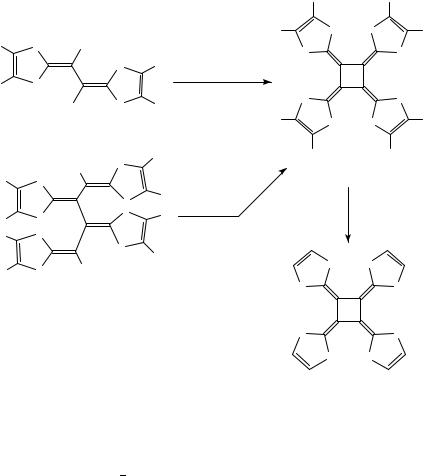
E S
E S
E S
E S E S
E S
E =COOMe
|
21. Synthesis and transformation of radialenes |
|
953 |
|||
|
|
|
|
E |
|
E |
|
|
|
E |
S |
S |
E |
|
Br |
|
|
S |
|
S |
|
|
E |
|
|
||
|
S |
0.5 Ni(PPh3 )4 |
|
|
|
|
|
|
|
|
|
||
|
|
|
Zn − Cu, THF, 25 °C |
|
|
|
|
|
|
30% |
S |
|
S |
Br |
S |
E |
|
|
||
|
|
|
|
|||
|
|
|
E |
S |
S |
E |
|
|
|
|
|
||
|
S |
E |
|
E |
|
E |
Br |
|
|
(106) |
|
||
|
|
|
|
|||
|
|
|
|
|
||
|
S |
E |
Ni (bpy) (cod) |
LiBr . H2O, |
|
|
|
|
|
|
|||
|
S |
E |
DMF |
88% |
|
|
|
HMPA , ∆ |
|
||||
|
|
|
3% |
|
|
|
|
|
|
|
|
|
|
|
S |
E |
|
|
|
|
|
|
|
S |
S |
|
|
|
Br |
|
|
|
||
|
|
|
|
|
|
|
|
|
|
|
S |
|
S |
|
|
|
|
S |
|
S |
S S
(107)
SCHEME 12. (continued)
generated in situ from NiBr2(PPh3)2, Et4NI and Zn (0.5:2:5 ratio) in THF solution, good yields of 94 can be obtained, and 95 and 96 are only minor products.
The scope of this method is illustrated by the preparation of other peralkylated [4]radialenes, such as 103 10566 and the functionalized radialene 10670,71 (Scheme 12). Removal of the carboxylate groups from the latter provided the very electron-rich radialene 107.
As we have mentioned, octaphenyl[4]radialene 109 can be obtained neither by photochemical nor by Ni(0)-catalyzed cyclodimerization of tetraphenylbutatriene. However, 109 has been prepared from 1,1-dibromo-2,2-diphenylethene via organocuprate intermediates (Scheme 13)72. The correct choice of the added copper(I) salt is crucial for the success of this transformation, but even then, formation of tetraphenylbutatriene (108) from the bis(1-bromovinyl)cuprate intermediate limits the yield of 109.
When the organocuprate methodology is applied to 1,1-dibromo-2-methylprop-1-ene, octamethyl[4]radialene (94) and decamethyl[5]radialene are the major products73. While this method does not offer any advantage over the Ni(0)-mediated syntheses of 94 (see above), it constitutes the only known synthesis of the permethylated [5]radialene (see Section II.C). For the sake of completeness, we mention that the Ni(0)-mediated dehydrohalogenation/cyclotetramerization of 1,1-dibromoalkenes is not an efficient route to [4]radialenes66.
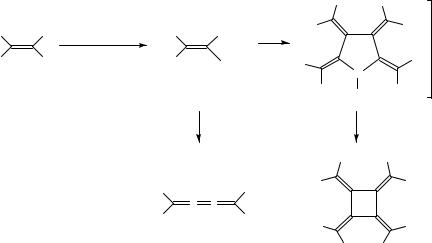
954 |
|
Gerhard Maas and Henning Hopf |
|
|
|
|||
|
|
|
|
|
|
Ph |
|
Ph |
|
|
|
|
|
|
|
||
Ph |
Br |
1. BuLi, THF, −90 °C |
|
Ph |
Br |
Ph |
|
Ph |
2. CuX, −80→20 °C |
|
|
|
|
||||
|
|
|
|
|
|
|
|
|
Ph |
Br |
|
|
Ph |
)2 CuLi |
Ph |
Cu |
Ph |
|
|
|
|
|
|
|
|
|
|
|
|
|
|
|
Ph |
Li |
Ph |
|
|
|
|
|
|
|
|
|
|
Ph |
Ph |
Ph |
Ph |
Ph |
Ph |
|
••
|
Ph |
|
|
|
|
Ph |
Ph |
Ph |
||||
|
|
|
|
|
|
|
|
|
|
|||
|
|
|
|
|
|
|
|
|
|
Ph |
Ph |
|
|
|
|
|
(108) |
|
|
|
|
(109) |
|||
|
|
|
|
|
|
|
|
|
|
|
|
|
CuX |
Ratio |
|
|
|
Yield of 108 |
Yield of 109 |
|
|||||
|
alkene :BuLi:CuX |
(%) |
|
|
|
(%) |
|
|
||||
CuI . PBu |
2 |
: |
2 |
: |
1 |
34 |
|
|
|
40 |
|
|
3 |
4 |
: |
2 |
: |
1 |
48 |
|
|
|
29 |
|
|
|
|
|
|
|
|
|||||||
CuCN |
2 |
: |
2 |
: |
1 |
traces |
41 |
|
|
|||
CuI |
2 |
: |
2 |
: |
1 |
Ph |
|
|
|
Ph (86%) |
|
|
|
|
|
|
|||||||||
|
|
|
|
|||||||||
|
|
|
|
|||||||||
SCHEME 13
An elusive [4]radialene synthesis has been reported by Sakurai. Irradiation of the 1,3,6,8,11,13,16,18-octasilacycloeicosan-4,9,14,19-tetrayne 110 in the presence of an equimolar amount of tricarbonyl(methylcyclopentadienyl)manganese initiates a skeletal rearrangement leading to 111, whereas in the presence of an excess of the metal carbonyl, [4]radialene 112 is formed (Scheme 14)74. Although the mechanistic details of these rearrangements are not known, it is likely that the intramolecular version of the transformation of bis(trialkylsilyl)acetylene into a (2,2-disilylvinylidene)manganese complex is involved.
Concerning the transformation of [4]radialenes, the parent compound (2) has been studied best, despite its high instability in solution at room temperature or in the solid state (see above). We have already mentioned that 2 can be kept indefinitely at 78 °C, but undergoes dimerization and polymerization in solution at 20 °C. The dimerization leads to cyclooctadiene derivative 11336. Trimethylenecyclobutane behaves analogously75, and 5,5,6,6-tetraphenyl[4]radialene 66 reacts in the same manner to give 114 at 60 °C in chloroform solution (equation 6)41. Since thermal (4 C 4) cycloadditions should not occur in a concerted manner, it has been suggested that this reaction is a stepwise process in which the reacting 1,2-dimethylenecyclobutene unit exhibits 1,4-diradical character39.
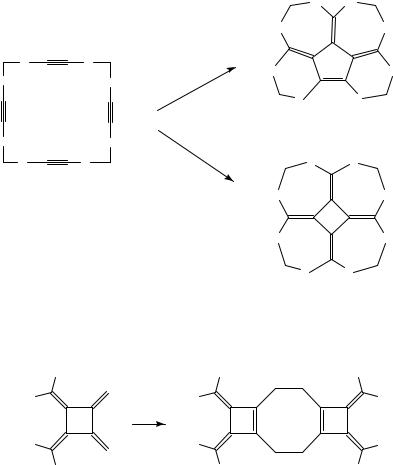
|
21. Synthesis and transformation of radialenes |
|
|
955 |
||||
|
|
|
|
|
Me2 |
Me2 |
|
|
|
|
|
|
|
Si |
|
Si |
|
|
|
|
|
|
Me2 Si |
|
SiMe2 |
|
Me2 |
Me2 |
(MeCp)Mn(CO)3 |
|
|
|
|
||
Si |
Si |
|
|
|
|
|||
(1 equiv), |
Me2 Si |
|
SiMe2 |
|||||
|
|
|
||||||
Me2 Si |
SiMe2 |
hν (>300 nm), |
|
|
|
|
||
|
|
THF, ∆ |
|
|
Si |
|
||
|
|
11% |
|
|
Si |
|
|
|
|
|
|
|
|
Me2 |
|
Me2 |
|
|
|
(MeCp)Mn(CO)3 |
(111) |
|
||||
|
|
(excess), |
|
|
||||
|
|
|
|
|
|
|||
Me2 Si |
SiMe2 |
hν (>300 nm), |
Me2 |
Me2 |
|
|||
|
|
THF, ∆ |
|
|||||
Si |
Si |
12% |
|
|
Si |
|
Si |
|
Me2 |
Me2 |
|
|
|
|
|
|
|
(110) |
|
|
|
|
Me2 Si |
|
SiMe2 |
|
|
|
|
|
|
Me2 Si |
|
SiMe2 |
|
|
|
|
|
|
Si |
|
Si |
|
|
|
|
|
|
Me2 |
|
Me2 |
|
|
|
|
|
|
|
(112) |
|
|
|
|
SCHEME 14 |
|
|
|
|
||
Notably, gas-phase thermolysis of 113 at 220 °C leads back to 276. |
|
|
|
|||||
R |
|
|
R |
|
|
R |
|
|
R |
|
R |
|
|
R |
|
||
2 |
|
∆ |
|
|
|
|
||
R |
|
R |
|
|
R |
(6) |
||
R |
|
|
R |
|
|
R |
|
|
R = H (2) |
|
|
|
|
(113) |
|
|
|
R = Ph (66) |
|
|
|
|
(114) |
|
|
|
In the gas phase, |
2 is a thermally very stable compound up to |
850 °C. Pyrolysis |
||||||
at 880 °C/10 3 Torr generates |
styrene (55 |
|
62%) |
and o-xylene |
(6%) along |
with |
||
|
||||||||
small amounts of phenylacetylene, benzene, toluene and unidentified hydrocarbons39. Cycloaddition reactions with dienophiles were among the first reactivity studies on 2; they were of course driven by the expectation to generate a cyclobutadiene structure by a twofold (4 C 2) cycloaddition. However, while 2 reacts readily with electrondeficient alkenes such as TCNE36, N-phenylmaleimide36, 4-phenyl-1,2,4-triazolinedione39 and diethyl azodicarboxylate39 to form 1:1 adducts 115, a second Diels-Alder reaction
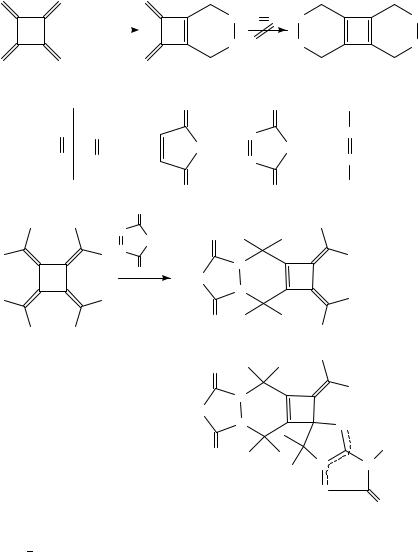
956 |
Gerhard Maas and Henning Hopf |
producing cyclobutadienes 116 could never be realized with an excess of these powerful dienophiles. Obviously, the activation barrier on the way to the antiaromatic 116 is prohibitive. Octamethyl[4]radialene (94) also undergoes but a single (4 C 2) cycloaddition with TCNE68. With 4-phenyl-1,2,4-triazolinedione, however, not only the 1:1 adduct 117 but also the dipolar 2:1 adduct 118 is formed; again, the reacting system is reluctant to form a cyclobutadiene.
|
X |
||||
+ |
|
|
|
∆ |
|
|
|
|
|||
X |
|||||
|
|||||
(2)
X C(CN)2
X C(CN)2
O
N
NPh
N
O
(94)
+
X X |
X X |
X |
|
X |
X |
X |
|
(115) |
|
(116) |
|
O |
O |
COOEt |
|
N |
|
N |
|
NPh |
NPh |
N |
|
N |
|
||
O |
O |
COOEt |
|
|
|||
O |
|
|
|
N |
|
|
|
PhN |
|
|
|
N |
|
|
|
O |
|
|
|
(117) |
|
||
O |
|
|
|
N |
|
|
|
PhN |
|
|
|
N |
|
O |
|
O |
|
Ph |
|
N |
N |
||
|
|||
N
O
(118)
Diels Alder reactions of 83 with various dienophiles occur regioselectively to form condensed tetraor pentacycles of the type 11977. (2C 1) Cycloaddition reactions between 2 and carbenes are also known78. While exposure of 2 to diazomethane in the presence of CuCl leads to a mixture of mono-, di-, triand tetracyclopropanated products, transfer of
